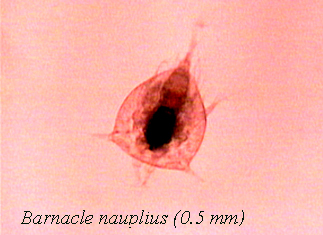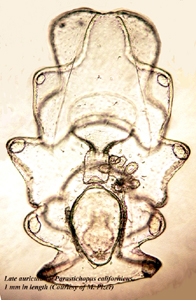Locomotion
in the Plankton
Most larvae and other
plankton are heavier than seawater, so they depend on buoyancy and/or locomotion
to stay suspended in the water column.  Some
larvae are buoyant from lipids stored in the egg or from the accumulation
of lipids during feeding. Thus, plankton may become more buoyant
throughout their larval stage. Barnacle nauplii larvae are a good example
because they feed throughout this stage and store lipids in specialized
oil cells. At the time of metamorphosis, these larvae settle in shallow
water, so buoyancy may be an important factor for finding the right adult
habitat.
Some
larvae are buoyant from lipids stored in the egg or from the accumulation
of lipids during feeding. Thus, plankton may become more buoyant
throughout their larval stage. Barnacle nauplii larvae are a good example
because they feed throughout this stage and store lipids in specialized
oil cells. At the time of metamorphosis, these larvae settle in shallow
water, so buoyancy may be an important factor for finding the right adult
habitat.
Plankton move through
the action of cilia (see the ciliary bands, which appear on the edges
of body lobes in the sea cucumber larva to the left),  antennae
(as seen in the copepod),
jointed appendages (as in the crab
larva), muscle contractions in the body wall (as in annelids)
and/or jet propulsion (as seen in this jellyfish
movie). Because the plankton are heavier than seawater, they depend
on these forms of locomotion just to stay in the water column (the density
of water is a constraint on the distance these small organisms are able
to move). Movement of flagella works by the flagellum beating back
and forth or in a helical rotary pattern. Cilia often occur in distinct
tracts and move together in waves, as seen in this ctenophore
movie. The ciliary movement provides a uniform pulsing force that has forward
(power) and recovery strokes.
antennae
(as seen in the copepod),
jointed appendages (as in the crab
larva), muscle contractions in the body wall (as in annelids)
and/or jet propulsion (as seen in this jellyfish
movie). Because the plankton are heavier than seawater, they depend
on these forms of locomotion just to stay in the water column (the density
of water is a constraint on the distance these small organisms are able
to move). Movement of flagella works by the flagellum beating back
and forth or in a helical rotary pattern. Cilia often occur in distinct
tracts and move together in waves, as seen in this ctenophore
movie. The ciliary movement provides a uniform pulsing force that has forward
(power) and recovery strokes.
Plankton
Home Annelida
Arthropoda
Chaetognatha
Chordata
Cnidaria & Ctenophora
Echinodermata
Mollusca
Invertebrates
2000
 antennae
(as seen in the copepod),
jointed appendages (as in the crab
larva), muscle contractions in the body wall (as in annelids)
and/or jet propulsion (as seen in this jellyfish
movie). Because the plankton are heavier than seawater, they depend
on these forms of locomotion just to stay in the water column (the density
of water is a constraint on the distance these small organisms are able
to move). Movement of flagella works by the flagellum beating back
and forth or in a helical rotary pattern. Cilia often occur in distinct
tracts and move together in waves, as seen in this ctenophore
movie. The ciliary movement provides a uniform pulsing force that has forward
(power) and recovery strokes.
antennae
(as seen in the copepod),
jointed appendages (as in the crab
larva), muscle contractions in the body wall (as in annelids)
and/or jet propulsion (as seen in this jellyfish
movie). Because the plankton are heavier than seawater, they depend
on these forms of locomotion just to stay in the water column (the density
of water is a constraint on the distance these small organisms are able
to move). Movement of flagella works by the flagellum beating back
and forth or in a helical rotary pattern. Cilia often occur in distinct
tracts and move together in waves, as seen in this ctenophore
movie. The ciliary movement provides a uniform pulsing force that has forward
(power) and recovery strokes.
 Some
larvae are buoyant from lipids stored in the egg or from the accumulation
of lipids during feeding. Thus, plankton may become more buoyant
throughout their larval stage. Barnacle nauplii larvae are a good example
because they feed throughout this stage and store lipids in specialized
oil cells. At the time of metamorphosis, these larvae settle in shallow
water, so buoyancy may be an important factor for finding the right adult
habitat.
Some
larvae are buoyant from lipids stored in the egg or from the accumulation
of lipids during feeding. Thus, plankton may become more buoyant
throughout their larval stage. Barnacle nauplii larvae are a good example
because they feed throughout this stage and store lipids in specialized
oil cells. At the time of metamorphosis, these larvae settle in shallow
water, so buoyancy may be an important factor for finding the right adult
habitat.